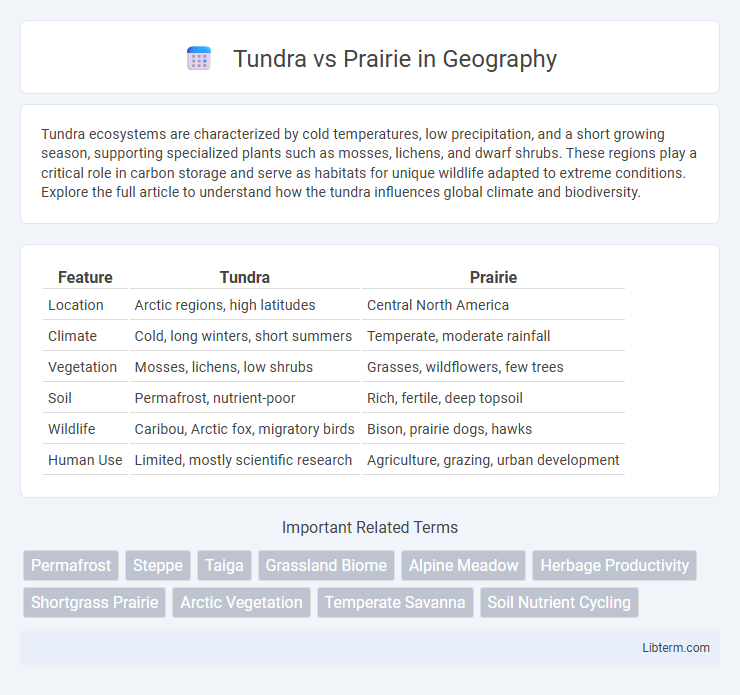Tundra ecosystems are characterized by cold temperatures, low precipitation, and a short growing season, supporting specialized plants such as mosses, lichens, and dwarf shrubs. These regions play a critical role in carbon storage and serve as habitats for unique wildlife adapted to extreme conditions. Explore the full article to understand how the tundra influences global climate and biodiversity.
Table of Comparison
| Feature | Tundra | Prairie |
|---|---|---|
| Location | Arctic regions, high latitudes | Central North America |
| Climate | Cold, long winters, short summers | Temperate, moderate rainfall |
| Vegetation | Mosses, lichens, low shrubs | Grasses, wildflowers, few trees |
| Soil | Permafrost, nutrient-poor | Rich, fertile, deep topsoil |
| Wildlife | Caribou, Arctic fox, migratory birds | Bison, prairie dogs, hawks |
| Human Use | Limited, mostly scientific research | Agriculture, grazing, urban development |
Introduction to Tundra and Prairie
The tundra biome, characterized by its cold temperatures, permafrost, and low biodiversity, supports hardy vegetation like mosses, lichens, and dwarf shrubs adapted to extreme conditions. In contrast, the prairie biome features vast grasslands with moderate rainfall, rich soil, and diverse grasses and wildflowers that sustain large herbivores and occasional fires play a key role in maintaining its ecosystem. Both biomes demonstrate unique adaptations to their distinct climates and soil conditions, influencing their flora and fauna composition.
Geographic Distribution
The tundra biome is primarily found in the Arctic regions of North America, Europe, and Asia, characterized by cold temperatures and permafrost. The prairie biome dominates the central United States and Canada, featuring vast grasslands with moderate precipitation. These distinct geographic distributions create unique ecosystems shaped by climate and soil conditions.
Climate and Weather Patterns
Tundras experience cold, harsh climates with long, bitter winters and short, cool summers, characterized by permafrost and low precipitation, often below 25 cm annually. Prairies have a temperate climate with hot summers and cold winters, receiving moderate rainfall between 50 to 90 cm annually, supporting tallgrass vegetation. The tundra's weather is marked by strong winds and minimal seasonal variation, while prairies exhibit more pronounced seasonal changes and occasional droughts.
Soil Composition and Fertility
Tundra soil is characterized by permafrost layers that limit nutrient availability and water drainage, resulting in low fertility and sparse organic matter. In contrast, prairie soil is predominantly rich in organic material and humus, with deep, well-drained profiles that support high fertility and robust plant growth. The significant difference in temperature and decomposition rates between tundra and prairie ecosystems directly influences their soil composition and nutrient cycling.
Dominant Vegetation
Tundra ecosystems are dominated by low-growing plants such as mosses, lichens, and dwarf shrubs adapted to cold temperatures and permafrost soils. Prairie landscapes primarily consist of tallgrass and mixed-grass species like big bluestem, buffalo grass, and needlegrass, thriving in well-drained, fertile soils. Vegetation in tundras adapts to short growing seasons and nutrient-poor substrates, while prairie plants are adapted to periodic fires and grazing pressures.
Animal Adaptations and Biodiversity
Tundra ecosystems support specialized animal adaptations such as thick fur, fat layers for insulation, and migration patterns to survive extreme cold and limited food availability, exemplified by species like caribou and Arctic foxes. Praries exhibit greater biodiversity with numerous herbivores like bison and predators like coyotes, adapted to warmer climates, open grasslands, and seasonal food abundance. The contrasting animal adaptations in tundra and prairie environments highlight evolutionary responses to temperature extremes, vegetation types, and resource availability.
Human Activities and Impact
Human activities in tundra regions, such as oil extraction and mining, lead to habitat disruption and permafrost degradation, accelerating climate change effects. In prairies, extensive agriculture and urban development result in soil erosion, loss of native grasslands, and reduced biodiversity. Both ecosystems face significant impacts from human-induced changes, threatening their unique flora and fauna.
Seasonal Variations
Tundra experiences extreme seasonal variations with long, harsh winters and short, cool summers, leading to limited plant growth during a brief thaw. Prairie regions exhibit more moderate seasonal changes with hot summers and cold winters, supporting diverse grasses and flowering plants adapted to periodic droughts and fires. Seasonal temperature fluctuations in prairies promote rich biodiversity, while tundra's permafrost restricts vegetation primarily to mosses, lichens, and low shrubs.
Ecosystem Services and Importance
Tundra ecosystems provide critical services such as carbon sequestration, climate regulation, and habitat for specialized wildlife, supporting biodiversity in extreme cold environments. Prairie ecosystems enhance soil fertility through deep-rooted grasses, promote water filtration, and sustain pollinators essential for agriculture and food production. Both ecosystems play vital roles in maintaining ecological balance, climate stability, and supporting human livelihoods through their unique services.
Conservation Challenges and Efforts
Tundra ecosystems face conservation challenges such as permafrost thawing and habitat disruption caused by climate change, leading to species vulnerability and altered carbon cycles. Prairie regions struggle with habitat loss due to agricultural expansion, invasive species, and fire suppression, which threaten native biodiversity and soil health. Conservation efforts include restoring native vegetation, implementing protected areas, and promoting sustainable land management practices to preserve ecosystem services and enhance resilience.
Tundra Infographic

 libterm.com
libterm.com